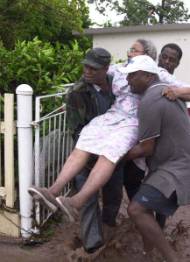|
|
In Nursing Home,
a Fight Lost to Rising Waters
By Gardiner Harris, New York Times
September 6, 2005

They nailed a table against one window, ran a heavy electric wheelchair with a table on top against another and pushed a couch against a door. These failed defenses are still in St. Rita's nursing home, as are at least 14 swollen, unrecognizable bodies.
St. Bernard Parish officials say that 32 of the home's roughly 60 residents died on Aug. 29, more than a week ago.
It is a measure of the enormity of the disaster that has struck southern Louisiana that no one has removed many of the bodies, and local officials say there are no immediate plans to do so. The flood victims still lie where they died - draped over a wheelchair, wrapped in a shower curtain, lying on a floor in several inches of muck.
The home, about 20 miles southeast of downtown New Orleans, is still surrounded by three feet of murky water. Eight vehicles are parked in front, covered in debris and mud.
Indeed, officials suspect that there may be hundreds of similar, though smaller scenes of death that will become apparent only after the water recedes and they are able to search every house in the region.
Many evacuees have told stories of near escapes, of busting out attic windows or axing through the roof to reach safety. The stories that will never be told are of those who tried and failed to make those escapes.
St. Rita's nursing home whispers this story.
Ricky Melerine, a St. Bernard Parish councilman, said the water in his area rose at least three feet from 10 to 10:15 that Monday morning. And it rose faster still after that.
Ronald Nunez, a local resident, said several men tried to save St. Rita's residents by floating some out on mattresses. Others were able to walk and float on their own to a nearby school, Mr. Nunez said.
And someone had time to put up a fight against the tide.
Nails were pounded through a table. Dressers were thrown against windows. Several electric wheelchairs were gathered near the front entrance, perhaps in hopes of evacuation. They simply ran out of time.
There are signs in the home that the water rose to the roof. Three inches of muck still cover the floors. Tadpoles wriggle in doorways. The stench is nauseating.
The story of St. Rita's leads locals here to voice the same frustrations they have about the entire disaster.
"Why didn't they evacuate?" Mr. Nunez asked. "Why?"
Mr. Nunez also said, with some bitterness, that his parish got only sporadic help from state and federal authorities.
St. Bernard's Parish has five major nursing homes with roughly 65 patients each, said Henry Rodriguez Jr., the parish president. There are another six smaller facilities, he said. Almost all but St. Rita's were evacuated before the storm.
Steve Kuiper, vice president of operations for Acadian Ambulance, said he was told that St. Rita's had an evacuation plan that depended on another nursing home. Acadian, by far the largest ambulance provider in the state, used helicopters to evacuate many of the parish's neediest medical cases after the storm hit. But Mr. Kuiper said he never heard from St. Rita's.
|
|



